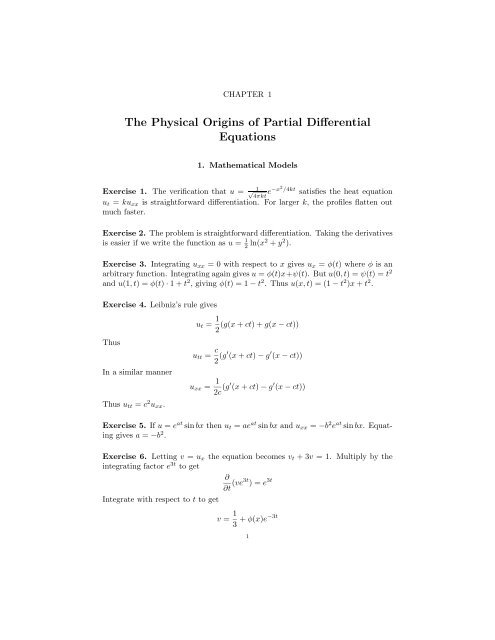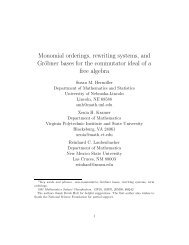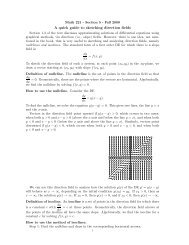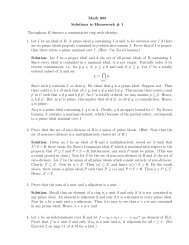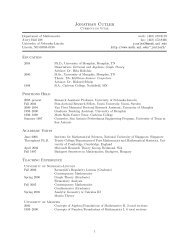The Physical Origins of Partial Differential Equations
The Physical Origins of Partial Differential Equations
The Physical Origins of Partial Differential Equations
You also want an ePaper? Increase the reach of your titles
YUMPU automatically turns print PDFs into web optimized ePapers that Google loves.
CHAPTER 1<br />
<strong>The</strong> <strong>Physical</strong> <strong>Origins</strong> <strong>of</strong> <strong>Partial</strong> <strong>Differential</strong><br />
<strong>Equations</strong><br />
1. Mathematical Models<br />
Exercise 1. <strong>The</strong> verification that u = 1<br />
√ 4πkt e −x2 /4kt satisfies the heat equation<br />
ut = kuxx is straightforward differentiation. For larger k, the pr<strong>of</strong>iles flatten out<br />
much faster.<br />
Exercise 2. <strong>The</strong> problem is straightforward differentiation. Taking the derivatives<br />
is easier if we write the function as u = 1<br />
2 ln(x2 + y 2 ).<br />
Exercise 3. Integrating uxx = 0 with respect to x gives ux = φ(t) where φ is an<br />
arbitrary function. Integrating again gives u = φ(t)x+ψ(t). But u(0,t) = ψ(t) = t 2<br />
and u(1,t) = φ(t) · 1 + t 2 , giving φ(t) = 1 − t 2 . Thus u(x,t) = (1 − t 2 )x + t 2 .<br />
Exercise 4. Leibniz’s rule gives<br />
Thus<br />
In a similar manner<br />
Thus utt = c 2 uxx.<br />
ut = 1<br />
(g(x + ct) + g(x − ct))<br />
2<br />
utt = c<br />
2 (g′ (x + ct) − g ′ (x − ct))<br />
uxx = 1<br />
2c (g′ (x + ct) − g ′ (x − ct))<br />
Exercise 5. If u = e at sin bx then ut = ae at sinbx and uxx = −b 2 e at sinbx. Equating<br />
gives a = −b 2 .<br />
Exercise 6. Letting v = ux the equation becomes vt + 3v = 1. Multiply by the<br />
integrating factor e 3t to get<br />
∂<br />
∂t (ve3t ) = e 3t<br />
Integrate with respect to t to get<br />
v = 1<br />
+ φ(x)e−3t<br />
3<br />
1
2 1. THE PHYSICAL ORIGINS OF PARTIAL DIFFERENTIAL EQUATIONS<br />
where φ is an arbitrary function. Thus<br />
<br />
u = vdx = 1<br />
3 x + Φ(x)e−3t + Ψ(t)<br />
Exercise 7. Let w = e u or u = lnw <strong>The</strong>n ut = wt/w and ux = wx/w, giving<br />
wxx = wxx/w − w 2 x/w 2 . Substituting into the PDE for u gives, upon cancellation,<br />
wt = wxx.<br />
Exercise 8. It is straightforward to verify that u = arctan(y/x) satisfies the<br />
Laplace equation. We want u → 1 as y → 0 (x > 0), and u → −1 as y → 0 (x < 0).<br />
So try<br />
u = 1 − 2 y<br />
arctan<br />
π x<br />
We want the branch <strong>of</strong> arctanz with 0 < arctan z < π/2 for z > 0 and π/2 <<br />
arctan z < π for z < 0.<br />
Exercise 9. Differentiate under the integral sign to obtain<br />
and<br />
Thus<br />
.<br />
uxx =<br />
uyy =<br />
Exercise 10. In preparation.<br />
∞<br />
0<br />
−ξ 2 c(ξ)e −ξy sin(ξx)dξ<br />
∞<br />
ξ<br />
0<br />
2 c(ξ)e −ξy sin(ξx)dξ<br />
uxx + uyy = 0<br />
2. Conservation Laws<br />
Exercise 1. Since A = A(x) depends on x, it cannot cancel from the conservation<br />
law and we obtain<br />
A(x)ut = −(A(x)φ)x + A(x)f<br />
Exercise 2. <strong>The</strong> solution to the initial value problem is u(x,t) = e−(x−ct)2. When<br />
c = 2 the wave forms are bell-shaped curves moving to the right at speed two.<br />
Exercise 3. Letting ξ = x − ct and τ = t, the PDE ut + cux = −λu becomes<br />
Uτ = −λU or U = φ(ξ)e −λt . Thus<br />
u(x,t) = φ(x − ct)e −λt<br />
Exercise 4. In the new dependent variable w the equation becomes wt +cwx = 0.<br />
Exercise 5. In preparation.
2. CONSERVATION LAWS 3<br />
Exercise 6. From Exercise 3 we have the general solution u(x,t) = φ(x − ct)e −λt .<br />
For x > ct we apply the initial condition u(x,0) = 0 to get φ ≡ 0. <strong>The</strong>refore<br />
u(x,t) = 0 in x > ct. For x < ct we apply the boundary condition u(0,t) = g(t) to<br />
get φ(−ct)e −λt = g(t) or φ(t) = e λt/c g(−t/c). <strong>The</strong>refore u(x,t) = g(t − x/c)e −λx/c<br />
in 0 ≤ x < ct.<br />
Exercise 7. Making the transformation <strong>of</strong> variables ξ = x − t, τ = t, the PDE<br />
becomes Uτ − 3U = τ, where U = U(ξ,τ). Multiplying through by the integrating<br />
factor exp(−3τ) and then integrating with respect to τ gives<br />
<br />
τ 1<br />
U = − + + φ(ξ)e<br />
3 9<br />
3τ<br />
or<br />
<br />
t 1<br />
u = − + + φ(x − t)e<br />
3 9<br />
3t<br />
Setting t = 0 gives φ(x) = x2 + 1/9. <strong>The</strong>refore<br />
<br />
t 1<br />
u = − + + ((x − t)<br />
3 9<br />
2 + 1<br />
9 )e3t<br />
Exercise 8. Letting n = n(x,t) denote the concentration in mass per unit volume,<br />
we have the flux φ = cn and so we get the conservation law<br />
nt + cnx = −r √ n 0 < x < l, t > 0<br />
<strong>The</strong> initial condition is u(x,0) = 0 and the boundary condition is u(0,t) = n0. To<br />
solve the equation go to characteristic coordinates ξ = x − ct and τ = t. <strong>The</strong>n the<br />
PDE for N = N(ξ,τ) is Nτ = −r √ N. Separate variables and integrate to get<br />
2 √ N = −rτ + Φ(ξ)<br />
Thus<br />
2 √ n = −rt + Φ(x − ct)<br />
Because the state ahead <strong>of</strong> the leading signal x = ct is zero (no nutrients have<br />
arrived) we have u(x,t) ≡ 0 for x > ct. For x < ct, behind the leading signal,<br />
we compute Φ from the boundary condition to be Φ(t) = 2 √ no − rt/c. Thus, for<br />
0 < x < ct we have<br />
2 √ n = −rt + 2 √ n0 − r<br />
(x − ct)<br />
c<br />
Along x = l we have n = 0 up until the signal arrives, i.e., for 0 < t < l/c. For<br />
t > l/c we have<br />
n(l,t) = ( √ n0 − rl<br />
2c )2<br />
Exercise 9. <strong>The</strong> graph <strong>of</strong> the function u = G(x + ct) is the graph <strong>of</strong> the function<br />
y = G(x) shifted to the left ct distance units. Thus, as t increases the pr<strong>of</strong>ile<br />
G(x + ct) moves to the left at speed c. To solve the equation ut − cux = F(x,t,u)<br />
on would transform the independent variables via x = x + ct, τ = t.<br />
Exercise 10. <strong>The</strong> conservation law for traffic flow is<br />
ut + φx = 0
4 1. THE PHYSICAL ORIGINS OF PARTIAL DIFFERENTIAL EQUATIONS<br />
If φ(u) = αu(β − u) is chosen as the flux law, then the cars are jammed at the<br />
density u = β, giving no movement or flux; if u = 0 there is no flux because there<br />
are no cars. <strong>The</strong> nonlinear PDE is<br />
or<br />
ut + (αu(β − u))x = 0<br />
ut + α(β − 2u)ux = 0<br />
Exercise 11. Transform to characteristic coordinates ξ = x − vt, τ = t to get<br />
Uτ = − αU<br />
, U = U(ξ,τ)<br />
β + U<br />
Separating variables and integrating yields, upon applying the initial condition and<br />
simplifying, the implicit equation<br />
u − αt − f(x) = β ln(u/f(x))<br />
Graphing the right and left sides <strong>of</strong> this equation versus u (treating x and t > 0 as<br />
parameters) shows that there are two crossings, or two roots u; the solution is the<br />
smaller <strong>of</strong> the two.<br />
Exercise 12. In preparation.<br />
3. Diffusion<br />
Exercise 1. We haveuxx(6,T) ≈ (58 − 2(64) + 72)/2 2 = 0.5. Since ut = kuxx > 0,<br />
the temperatue will increase. We have<br />
ut(T,6) ≈<br />
This gives u(T + 0.5,6) ≈ 64.005.<br />
u(T + 0.5,6) − u(T,6)<br />
0.5<br />
Exercise 2. Taking the time derivative<br />
l<br />
l<br />
E ′ (t) = d<br />
dt<br />
u<br />
0<br />
2 dx = 2uutdx = 2k<br />
0<br />
= 2kuux | l <br />
0 −2k u 2 x ≤ 0<br />
≈ kuxx(T,6) ≈ 0.02(0.5)<br />
l<br />
0<br />
uuxxdx<br />
Thus E in nonincreasing, so E(t) ≤ E(0) = l<br />
0 u0(x)dx. Next, if u0 ≡ 0 then<br />
E(0) = 0. <strong>The</strong>refore E(t) ≥ 0, E ′ (t) ≤ 0,E(0) = 0. It follows that E(t) = 0.<br />
Consequently u(x,t) = 0.<br />
Exercise 3. Take<br />
w(x,t) = u(x,t) −<br />
h(t) − g(t)<br />
(x − l) − g(t)<br />
l
3. DIFFUSION 5<br />
<strong>The</strong>n w will satisfy homogeneous boundary conditions. We get the problem<br />
where<br />
F(x,t) =<br />
wt = kwxx − F(x,t), 0 < x < l, t > 0<br />
w(0,t) = w(l,t) = 0, t > 0<br />
w(x,0) = G(x), 0 < x < l<br />
l − x<br />
(h<br />
l<br />
′ (t) − g ′ (t)) − g ′ (t), G(x) = u(x,0) −<br />
Exercise 4. This is a straightforward calculation.<br />
Exercise 5. <strong>The</strong> steady state problem for u = u(x) is<br />
ku ′′ + 1 = 0, u(0) = 0, u(1) = 1<br />
h(0) − g(0)<br />
(x − l) − g(0)<br />
l<br />
Solving this boundary value problem by direct integration gives the steady state<br />
solution<br />
u(x) = − 1<br />
2k x2 = (1 + 1<br />
2k )x<br />
which is a concave down parabolic temperature distribution.<br />
Exercise 6. <strong>The</strong> steady-state heat distribution u = u(x) satisfies<br />
ku ′′ − au = 0, u(0) = 1, u(1) = 1<br />
<strong>The</strong> general solution is u = c1 cosh a/kx + c2 sinh a/kx. <strong>The</strong> constants c1 and<br />
c2 can be determined by the boundary conditions.<br />
Exercise 7. <strong>The</strong> boundary value problem is<br />
ut = Duxx + ru(1 − u/K), 0 < x < l, t > 0<br />
ux(0,t) = ux(l,t) = 0, t > 0<br />
u(x,0) = ax(l − x), 0 < x < l<br />
For long times we expect a steady state density u = u(x) to satisfy −Du ′′ +ru(1 −<br />
u/K) = 0 with insulated boundary conditions u ′ (0) = u ′ (l) = 0. <strong>The</strong>re are two<br />
obvious solutions to this problem, u = 0 and u = K. From what we know about<br />
the logistics equation<br />
du<br />
= ru(1 − u/K)<br />
dt<br />
(where there is no spatial dependence and no diffusion, and u = u(t)), we might<br />
expect the the solution to the problem to approach the stable equilibrium u = K.<br />
In drawing pr<strong>of</strong>iles, note that the maximum <strong>of</strong> the initial condition is al 2 /4. So<br />
the two cases depend on whether this maximum is below the carrying capacity or<br />
above it. For example, in the case al 2 /4 < K we expect the pr<strong>of</strong>iles to approach<br />
u = K from below.<br />
Exercise 8 <strong>The</strong>se facts are directly verified.
6 1. THE PHYSICAL ORIGINS OF PARTIAL DIFFERENTIAL EQUATIONS<br />
Exercise 1. We have<br />
4. PDE Models in Biology<br />
ut = (D(u)ux)x = D(u)uxx + D(u)xux<br />
= D(u)uxx + D ′ (u)uxux.<br />
Exercise 2. <strong>The</strong> steady state equation is (Du ′ ) ′ = 0, where u = u(x). If D =<br />
constant then u ′′ = 0 which has a linear solution u(x) = ax + b. Applying the two<br />
end conditions (u(0) = 4 and u ′ (2) = 1) gives b = 4 and a = 1. Thus u(x) = x + 4.<br />
<strong>The</strong> left boundary condition means the concentration is held at the value u = 4,<br />
and the right boundary condition means −Du ′ (2) = −D, meaning that the flux is<br />
−D. So matter is entering the system at L = 2 (moving left). In the second case<br />
we have <br />
1<br />
1 + x u′<br />
′<br />
= 0.<br />
<strong>The</strong>refore<br />
or<br />
1<br />
1 + x u′ = a<br />
u ′ = a(1 + x).<br />
<strong>The</strong> right boundary condition gives a = 1/3. Integrating again and applying the<br />
left boundary condition gives<br />
u(x) = 1 1<br />
x +<br />
3 6 x2 + 4.<br />
In the third case the equation is<br />
or uu ′ = a.This is the same as<br />
which gives<br />
(uu ′ ) ′ = 0,<br />
1<br />
2 (u2 ) ′ = a,<br />
1<br />
2 u2 = ax + b.<br />
¿From the left boundary condition b = 8. Hence<br />
u(x) = √ 2ax + 16.<br />
Now the right boundary condition can be used to obtain the other constant a .<br />
Proceeding,<br />
u ′ a<br />
(2) =<br />
2 √ = 1.<br />
a + 4<br />
Thus a = 2 + √ 20.<br />
Exercise 3. <strong>The</strong> general solution <strong>of</strong> Du ′′ − cu ′ = 0 is u(x) = a + be cx/D . In the<br />
second case the equation is Du ′′ − cu ′ + ru = 0. <strong>The</strong> roots <strong>of</strong> the characteristic<br />
polynomial are<br />
λ± = c<br />
2D ±<br />
√<br />
c2 − 4Dr<br />
.<br />
2D
4. PDE MODELS IN BIOLOGY 7<br />
<strong>The</strong>re are three cases, depending upon upon the discriminant c2−4Dr. If c2−4Dr =<br />
) and the general solution has the form<br />
0 then the roots are equal ( c<br />
2D<br />
u(x) = ae cx/2D + bxe cx/2D .<br />
If c 2 − 4Dr > 0 then there are two real roots and the general solution is<br />
u(x) = ae λ+x + be λ−x .<br />
If c2 − 4Dr < 0 then the roots are complex and the general solution is given by<br />
u(x) = ae cx/2D<br />
√ √ <br />
4Dr − c2 4Dr − c2 acos x + bsin x .<br />
2D<br />
2D<br />
Exercise 4. If u is the concentration, use the notation u = v for 0 < x < L/2, and<br />
u = w for L/2 < x < L.<strong>The</strong> PDE model is then<br />
vt = vxx − λv, 0 < x < L/2,<br />
wt = wxx − λw, L/2 < x < L.<br />
<strong>The</strong> boundary conditions are clearly v(0,t) = w(L,t) = 0, and continuity at the<br />
midpoint forces v(L/2) = w(L/2). To get a condition for the flux at the midpoint<br />
we take a small interval [L/2 − ǫ,L/2 + ǫ]. <strong>The</strong> flux in at the left minus the flux<br />
out at the right must equal 1, the amount <strong>of</strong> the source. In symbols,<br />
Taking the limit as ǫ → 0 gives<br />
−vx(L/2 − ǫ,t) + wx(L/2 + ǫ) = 1.<br />
−vx(L/2,t) + wx(L/2) = 1.<br />
So, there is a jump in the derivative <strong>of</strong> the concentration at the point <strong>of</strong> the source.<br />
<strong>The</strong> steady state system is<br />
with conditions<br />
v ′′ − λv = 0, 0 < x < L/2,<br />
w ′′ − λw = 0, L/2 < x < L,<br />
v(0) = w(L) = 0,<br />
v(L/2) = w(L/2),<br />
−v ′ (L/2) + w ′ (L/2) = 1.<br />
Let r = √ λ. <strong>The</strong> general solutions to the DEs are<br />
v = ae rx + be −rx , w = ce rx + de −rx .<br />
<strong>The</strong> four constants a,b,c,d may be determined by the four subsiduary conditions.<br />
Exercise 5. <strong>The</strong> steady state equations are<br />
v ′′ = 0, 0 < x < ξ,<br />
w ′′ = 0, ξ < x < L,
8 1. THE PHYSICAL ORIGINS OF PARTIAL DIFFERENTIAL EQUATIONS<br />
<strong>The</strong> conditions are<br />
v(0) = w(L) = 0,<br />
v(ξ) = w(ξ),<br />
−v ′ (ξ) + w ′ (ξ) = 1.<br />
Use these four conditions to determine the four constants in the general solution to<br />
the DEs. We finally obtain the solution<br />
ξ − L x − L<br />
v(x) = x, w(x) =<br />
L L ξ.<br />
Exercise 6. <strong>The</strong> equation is<br />
ut = uxx − ux, 0 < x < L<br />
(With no loss <strong>of</strong> generality we have taken the constants to be equal to one). Integrating<br />
from x = 0 to x = L gives<br />
L<br />
0<br />
utdx =<br />
L<br />
0<br />
uxxdx −<br />
L<br />
0<br />
uxdx.<br />
Using the fundamental theorem <strong>of</strong> calculus and bringing out the time derivative<br />
gives<br />
∂<br />
∂t<br />
L<br />
0<br />
udx = ux(L,t) − ux(0,t) − u(L,t) + u(0,t) = −flux(L,t) + flux(0,t) = 0.<br />
Exercise 7. <strong>The</strong> model is<br />
ut = Duxx + agux,<br />
u(∞,t) = 0, −Dux(0,t) − agu(0,t) = 0.<br />
<strong>The</strong> first boundary condition states the concentration is zero at the bottom (a great<br />
depth), and the second condition states that the flux through the surface is zero,<br />
i.e., no plankton pass through the surface. <strong>The</strong> steady state equation is<br />
which has general solution<br />
Du ′′ + agu ′ = 0,<br />
u(x) = A + Be −agx/D .<br />
<strong>The</strong> condition u(∞) = 0 forces A=0. <strong>The</strong> boundary condition −Du ′ (0)−agu(0) = 0<br />
is satisfied identically. So we have<br />
u(x) = u(0)e −agx/D .<br />
Exercise 8. Notice that the dimensions <strong>of</strong> D are length-squared per unit time,<br />
so we use D = L 2 /T, where L and T are the characteristic length and time,<br />
respectively. For sucrose,<br />
For the insect,<br />
L = √ DT = (4.6 × 10 −6 )(60 × 60 × 24) = 0.63 cm.<br />
T = L2<br />
D<br />
= 100002<br />
2.0 × 10 −1 = 5 × 108 sec = 6000 days.
4. PDE MODELS IN BIOLOGY 9<br />
Exercise 9. Solve each <strong>of</strong> the DEs, in linear, cylindrical, and spherical coordinates,<br />
respectively:<br />
Du ′′ = 0,<br />
D<br />
r (ru′ ) ′ = 0,<br />
D<br />
ρ 2 (ρ2 u ′ ) ′ = 0.<br />
Exercise 10. Let q = 1 − p and begin with the equation<br />
or<br />
u(x,t + τ) − u(x,t) = pu(x − h,t) + qu(x + h,t) − pu(x,t) − qu(x,t),<br />
u(x,t + τ) = pu(x − h,t) + qu(x + h,t).<br />
Expanding in Taylor series (u and its derivatives are evaluated at (x,t) ),<br />
or<br />
<strong>The</strong>n<br />
u + utτ + · · · = pu − puxh + 1<br />
2 puxxh 2 + qu + quxh + 1<br />
2 quxxh 2 + · · ·,<br />
τut = (1 − 2p)uxh + 1<br />
2 uxxh 2 + · · ·.<br />
h<br />
ut = (1 − 2p)ux<br />
Taking the limit as h,τ → 0 gives<br />
with appropriately defined special limits.<br />
τ<br />
ut = cux + Duxx,<br />
Exercise 11. Similar to the example on page 30.<br />
+ h2<br />
2τ uxx + · · ·.<br />
Exercise 12. Draw two concentric circles <strong>of</strong> radius r = a and r = b. <strong>The</strong> total<br />
amount <strong>of</strong> material in between is<br />
2π<br />
b<br />
a<br />
u(r,t)rdr.<br />
<strong>The</strong> flux through the circle r = a is −2πaDur(a,t) and the flux through r=b is<br />
−2πbDur(b,t). <strong>The</strong> time rate <strong>of</strong> change <strong>of</strong> the total amount <strong>of</strong> material in between<br />
equals the flux in minus the flux out, or<br />
or<br />
2π ∂<br />
∂t<br />
b<br />
a<br />
b<br />
Since a and b are arbitrary,<br />
a<br />
u(r,t)rdr. = −2πaDur(a,t) + 2πbDur(b,t),<br />
ut(r,t)rdr =<br />
b<br />
a<br />
D ∂<br />
∂r (rur(r,t))dr.<br />
ut(r,t)r = D ∂<br />
∂r (rur(r,t)).
10 1. THE PHYSICAL ORIGINS OF PARTIAL DIFFERENTIAL EQUATIONS<br />
5. Vibrations and Acoustics<br />
Exercise 1. In the vertical force balance the term − l<br />
0 gρ0(x)dx should be added<br />
to the right side to account for gravity acting downward.<br />
Exercise 2. In the vertical force balance the term −int l 0ρ0(x)kutdx should be<br />
added to the right side to account for damping.<br />
Exercise 4. <strong>The</strong> initial conditions are found by setting t = 0 to obtain<br />
un(x,0) = sin nπx<br />
l<br />
<strong>The</strong> temporal frequency <strong>of</strong> the oscillation is ω ≡ nπc/l with period 2π/ω. As the<br />
length l increases, the frequency decreases, making the period <strong>of</strong> oscillation longer.<br />
<strong>The</strong> tension is τ satisfies ρ0c 2 = τ. As τ increases the frequency increases so<br />
the oscillations are faster. Thus, tighter strings produce higher frequencies; longer<br />
string produce lower frequencies.<br />
Exercise 5. <strong>The</strong> calculation follows directly by applying the hint.<br />
Exercise 6. We have<br />
c 2 = dp<br />
dρ = kγργ−1 = γp<br />
ρ<br />
Exercise 8. Assume ˜ρ(x,t) = F(x − ct), a right traveling wave, where F is to<br />
be determined. <strong>The</strong>n this satisfies the wave equation automatically and we have<br />
˜ρ(0,t) = F(−ct) = 1 − 2cos t, which gives F(t) = 1 − 2cos(−t/c). <strong>The</strong>n<br />
˜ρ(x,t) = 1 − 2cos(t − x/c)<br />
6. Quantum Mechanics<br />
Exercise 1. This is a straightforward verification using rules <strong>of</strong> differentiation.<br />
Exercise 2. Observe that<br />
|Ψ(x,t)| = |y(x)||Ce −iEt/ | = C|y(x)|<br />
Exercise 3. Substitute y = e−ax2 into the Schrödinger equation to get<br />
E = 2 a/m, a 2 = 1<br />
4 mk/2<br />
This gives<br />
y(x) = Ce −0.5√mkx 2 /<br />
To find C impose the normality condition <br />
R y(x)2dx = 1 and obtain<br />
1/4 mk<br />
C =<br />
2π
7. HEAT FLOW IN THREE DIMENSIONS 11<br />
Exercise 5. Let b 2 ≡ 2mE/ 2 . <strong>The</strong>n the ODE<br />
y ′′ + b y = 0<br />
has general solution<br />
y(x) = Asin bx + B cos bx<br />
<strong>The</strong> condition y(0) = 0 forces B = 0. <strong>The</strong> condition y(π) = 0 forces sinbπ = 0,<br />
and so (assuming B = 0) b must be an integer, i.e., n2 ≡ 2mE/2 . <strong>The</strong> probability<br />
density functions are<br />
y 2 n(x) = B 2 sin 2 nx<br />
with the constants B chosen such that π<br />
0 y2dx = 1. One obtains B = 2/π. <strong>The</strong><br />
probabilities are<br />
0<br />
0<br />
.25y 2 n(x)dx<br />
7. Heat Flow in Three Dimensions<br />
In these exercises we use the notation ∇ for the gradient operation grad.<br />
Exercise 1. We have<br />
div(∇u) = div(ux,uy,uz) = uxx + uyy + uzz<br />
Exercise 2. For nonhomogeneous media the conservation law (1.40) becomes<br />
cρut − div(K(x,y,z)∇u) = f<br />
So the conductivity K cannot be brought out <strong>of</strong> the divergence.<br />
Exercise 3. Integrate both sides <strong>of</strong> the PDE over Ω to get<br />
<br />
fdV = −K∆udV = −Kdiv(∇u)dV<br />
Ω<br />
Ω<br />
<br />
Ω<br />
<br />
= −K ∇u · ndA = gdA<br />
∂Ω<br />
<strong>The</strong> left side is the net heat generated inside Ω from sources; the right side is the<br />
net heat passing through the boundary. For steady-state conditions, these must<br />
balance.<br />
Exercise 4. Follow the suggestion and use the divergence theorem.<br />
Exercise 5. Follow the suggestion in the hint to obtain<br />
<br />
<br />
− ∇u · ∇u dV = λ u 2 dV<br />
Ω<br />
Both integrals are nonnegative, and so λ must be nonpositive. Note that λ = 0;<br />
otherwise u = 0.<br />
Exercise 6. This calculation is on page 137 <strong>of</strong> the text.<br />
Exercise 7. In preparation.<br />
Ω<br />
∂Ω
12 1. THE PHYSICAL ORIGINS OF PARTIAL DIFFERENTIAL EQUATIONS<br />
8. Laplace’s Equation<br />
Exercise 1. <strong>The</strong> temperature at the origin is the average value <strong>of</strong> the temperature<br />
around the boundary, or<br />
u(0,0) = 1<br />
2π<br />
2π<br />
0<br />
(3sin 2θ + 1)dθ<br />
<strong>The</strong> maximum and minimum must occur on the boundary. <strong>The</strong> function f(θ) =<br />
3sin 2θ + 1 has an extremum when f ′ (θ) = 0 or 6cos 2θ = 0. <strong>The</strong> maxima then<br />
occur at θ = π/4,5π/4 and the minima occur at θ = 3π/4,7π/4.<br />
Exercise 2. We have u(x) = ax + b. But u(0) = b = T0 and u(l) = al + T0 = T1,<br />
giving a = (T1 − T0)/l. Thus<br />
u(x) = T1 − T0<br />
x + T0<br />
l<br />
which is a straight line connecting the endpoint temperatures. When the right end<br />
is insulated the boundary condition becomes u ′ (l) = 0. Now we have a = 0 and<br />
b = T0 which gives the constant distribution<br />
u(x) = T0<br />
Exercise 3. <strong>The</strong> boundary value problem is<br />
−((1 + x 2 )u ′ ) ′ = 0, u(0) = 1, u(1) = 4<br />
Integrating gives (1 + x 2 )u ′ = c1, or u ′ = c1/(1 + x 2 ). Integrating again gives<br />
u(x) = c1 arctan x + c2<br />
But u(0) = c2 = 1, and u(1) = c1 arctan 1 + 1 = 4. <strong>The</strong>n c1 = 6/π.<br />
Exercise 4. Assume u = u(r) where r = x2 + y2 . <strong>The</strong> chain rule gives<br />
ux = u ′ (r)rx = u ′ x<br />
(r) <br />
x2 + y2 <strong>The</strong>n, differentiating again using the product rule and the chain rule gives<br />
Similarly<br />
<strong>The</strong>n<br />
uxx = x2<br />
r2 u′′ (r) + y2<br />
r3 uyy = y2<br />
r2 u′′ (r) + x2<br />
r3 ∆u = u ′′ + 1<br />
r u′ = 0<br />
This last equation can be written<br />
which gives the radial solutions<br />
(ru ′ ) ′ = 0<br />
u = aln r + b
9. CLASSIFICATION OF PDES 13<br />
which are logrithmic. <strong>The</strong> one dimensional Laplace equation u ′′ = 0 has linear<br />
solutions u = ax + b, and the three dimensional Laplace equation has algebraic<br />
power solutions u = aρ −1 + b. In the two dimensional problem we have u(r) =<br />
alnr + b with u(1) = 0 and u(2) = 10. <strong>The</strong>n b = 0 and a = 10/ln 2. Thus<br />
ln r<br />
u(r) = 10<br />
ln 2<br />
Exercise 5. We have ∇V = E. Taking the divergence <strong>of</strong> both sides gives ∆V =<br />
div∇V = div E = 0.<br />
Exercise 1. <strong>The</strong> equation<br />
9. Classification <strong>of</strong> PDEs<br />
uxx + 2kuxt + k 2 utt = 0<br />
is parabolic because B 2 − 4AC = 4k 2 − 4k 2 = 0. Make the transformation<br />
x = ξ, τ = x − (B/2C)t = x − t/k<br />
<strong>The</strong>n the PDE reduces to the canonical form Uξξ = 0. Solve by direct integration.<br />
<strong>The</strong>n Uξ = f(τ) and U = ξf(τ) + g(τ). <strong>The</strong>refore<br />
where f,g are arbitrary functions.<br />
u = xf(x − t/k) + g(x − t/k)<br />
Exercise 2. <strong>The</strong> equation 2uxx − 4uxt + ux = 0 is hyperbolic. Make the transformation<br />
ξ = 2x + t,τ = t and the PDE reduces to the canonical form<br />
Uξτ − 1<br />
4 Uξ = 0<br />
Make the substitution V = Uξ to get Vτ = 0.25V , or V = F(ξ)e τ/4 . <strong>The</strong>n U =<br />
f(ξ)e τ/4 + g(τ), giving<br />
u = f(2x + t)e t/4 + g(t)<br />
Exercise 3. <strong>The</strong> equation xuxx−4uxt = 0 is hyperbolic. Under the transformation<br />
ξ = t, τ = t + 4ln x the equation reduces to<br />
Proceeding as in Exercise 2 we obtain<br />
.<br />
Uξτ + 1<br />
U = 0<br />
4<br />
u = f(t + 4ln x)e t/4 + g(t)<br />
Exercise 5. <strong>The</strong> discriminant for the PDE<br />
uxx − 6uxy + 12uyy = 0
14 1. THE PHYSICAL ORIGINS OF PARTIAL DIFFERENTIAL EQUATIONS<br />
is D = −12 is negative and therefore it is elliptic. Take b = 1/4 + √ 3i/12 and<br />
define the complex transformation ξ = x + by, τ = x + by. <strong>The</strong>n take<br />
α = 1 1<br />
(ξ + τ) = x +<br />
2 4 y<br />
and<br />
β = 1<br />
√<br />
3<br />
(ξ − τ) =<br />
2i 12 y<br />
<strong>The</strong>n the PDE reduces to Laplace’s equation uαα + uββ = 0.<br />
Exercise 6. In preparation.<br />
Exercise 7. In preparation.


